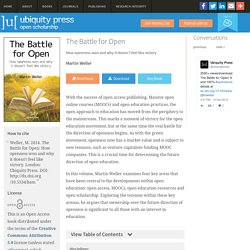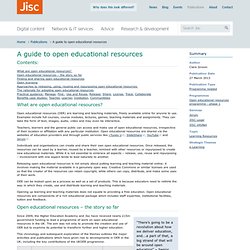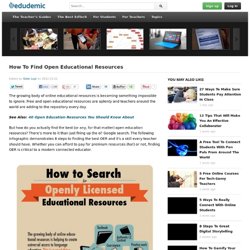

Resources. Ubiquity Press. The Battle for Open: How Openness Won and Why it Doesn’t Feel Like Victory, by Martin Weller Sandra Leaton Gray As an academic living through the rapid and sometimes brutal commoditisation of universities, there are days when I secretly feel a sense of foreboding, as though I’m some sort of well-meaning druid about to be slaughtered by the Romans.

Beware, therefore, if you are of a nervous disposition and about to launch into reading this book. It may make you want to pull the duvet over your head and never get up again, once the stark future of academic publishing is laid out in front of you on your Kindle (if you can manage to download it, of course, which I struggled with). Martin Weller’s book is written in a beguilingly approachable style, reminiscent of 101 position papers and blog posts aimed at thrashing out the role of the modern university within contemporary society. Open Educational Resources (OERs) for digital scholars. A guide to open educational resources. Contents: What are open educational resources?

Open educational resources (OER) are learning and teaching materials, freely available online for anyone to use. Examples include full courses, course modules, lectures, games, teaching materials and assignments. They can take the form of text, images, audio, video and may even be interactive. Teachers, learners and the general public can access and make use of open educational resources, irrespective of their location or affiliation with any particular institution. Individuals and organisations can create and share their own open educational resources. Releasing open educational resources is not simply about putting learning and teaching material online; it involves making the material available in a genuinely open way. OER can be looked upon as a process as well as a set of products. Opening up learning and teaching materials does not equate to providing a free education. Open educational resources – the story so far Open licensing Manage Find.
OpenLearn. Easy guide to Creative Commons Attribution and additional resources. In the days when great edtech was a child printing out a Word document to give to the teacher or a teacher presenting a lesson to the class via a garish PowerPoint slideshow complete with lasertext transitions(!?!)

, the last thing on anyone’s mind was who owned that picture I downloaded from Google. To be honest, I would think the vast majority of users still think every image on the “Interwebs” is up for grabs, along with all those movies and songs we’ve been ‘innocently’ downloading over the years. Now, however with the advent of Web 2.0 online publishing as a norm in schools, protocols and expectations have to change. A picture on a printed Word document is one thing – it is hidden from public view and the owner of the image is none the wiser. Technically still not abiding by copyright possibly ( I’m not a lawyer ) but highly unlikely you will be chased down for the crime. How To Attribute Creative Commons Photos by Foter One of the best sources for CC attributed images is Flickr.
Ambiguity, OER & Open Badges. How To Find Open Education Resources. The growing body of online educational resources is becoming something impossible to ignore.

Free and open educational resources are aplenty and teachers around the world are adding to the repository every day. See Also: 40 Open Education Resources You Should Know About But how do you actually find the best (or any, for that matter) open education resources? There’s more to it than just firing up the ol’ Google search. The following infographic demonstrates 8 steps to finding the best OER and it’s a skill every teacher should have. Designed by coerll. Open Educational Resources.